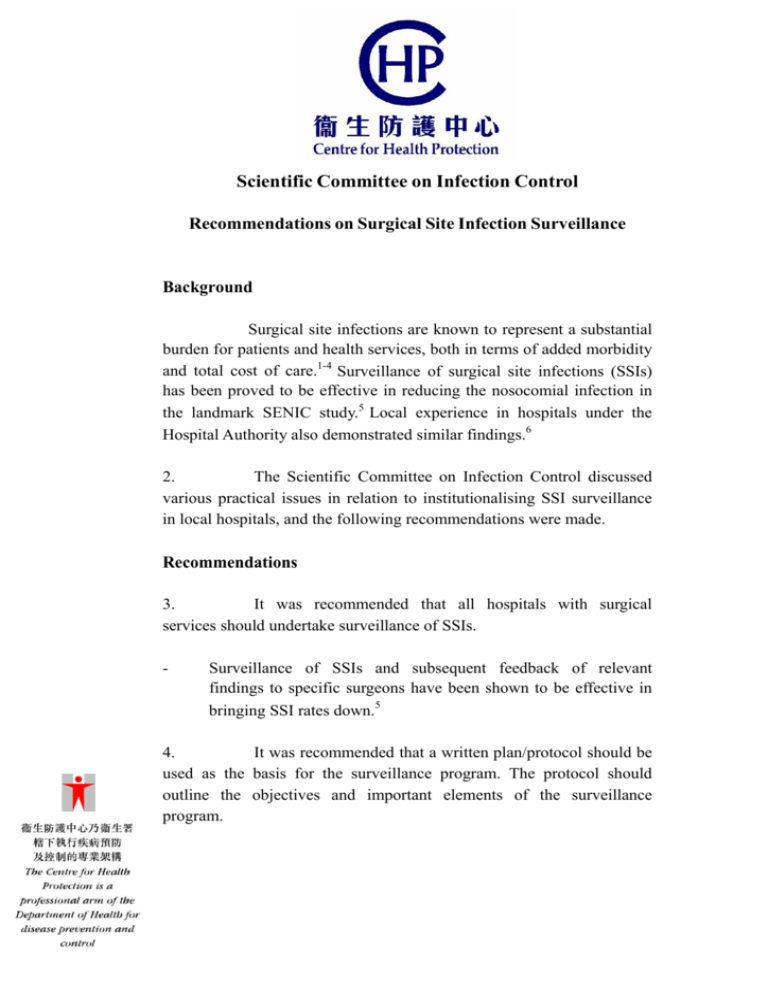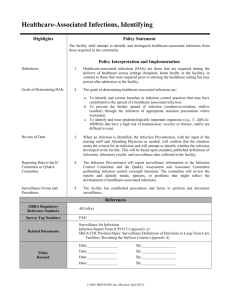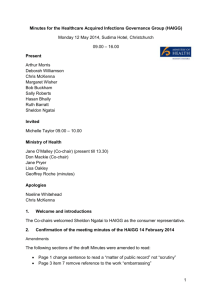Recommendations on Surgical Site Infection Surveillance (February
advertisement

Scientific Committee on Infection Control Recommendations on Surgical Site Infection Surveillance Background Surgical site infections are known to represent a substantial burden for patients and health services, both in terms of added morbidity and total cost of care.1-4 Surveillance of surgical site infections (SSIs) has been proved to be effective in reducing the nosocomial infection in the landmark SENIC study.5 Local experience in hospitals under the Hospital Authority also demonstrated similar findings.6 2. The Scientific Committee on Infection Control discussed various practical issues in relation to institutionalising SSI surveillance in local hospitals, and the following recommendations were made. Recommendations 3. It was recommended that all hospitals with surgical services should undertake surveillance of SSIs. - Surveillance of SSIs and subsequent feedback of relevant findings to specific surgeons have been shown to be effective in bringing SSI rates down.5 4. It was recommended that a written plan/protocol should be used as the basis for the surveillance program. The protocol should outline the objectives and important elements of the surveillance program. - A structured plan and protocol allowed the objective and scope of surveillance to be clearly defined.7 This formed the basis of the surveillance programme and provided the frontline staff with a clear guidance for reference. The Hospital Authority (HA) has already rolled out the Protocol for HA Surgical Site infection Surveillance in 2002.8 5. It was recommended that the surveillance should be an ongoing and active one which measured the incidence of the SSIs.1 - A programme of continuous SSI surveillance and feedback was shown to be associated with reduction in total SSI rate in an overseas university hospital, while the decline halted during the period of interruption.9 6. It was recommended that the findings of SSI surveillance programme should be made available to practicing surgeons. - Studies have proved the effectiveness of surveillance with feedback of findings to specific surgeons in lowering the SSI rate.5,8,10-12 Such summary report should calculate the operation-specific rate and be appropriately stratified e.g. with National Nosocomial Infection Surveillance (NNIS) risk index.1 - The optimum frequency of such rate calculation and reporting would be determined by case-load of individual unit and original objectives set.7 7. It was recommended that certain wound categories (clean, clean contaminated, contaminated and dirty) should be included in the scope of the SSI surveillance. - Large scale studies revealed that SSI surveillance with feedback mechanism would effectively lower the SSI rate of clean operations8,10, as well as procedures of all other wound categories.5,11 - The operations with high volume or known to have high risks of developing SSI could also be selectively chosen to perform surveillance.13,14 8. It was recommended that the elements of surveillance, including definitions of SSI and the method for calculating the various rates, should be used with consistency over time. - In general, the CDC definitions of SSI should be used for identifying SSI in surgical patients.15 Otherwise, the protocol should state clearly 2 the definition and any modification under scientific grounds.* The definitions should be used consistently over time for trend analysis. Even a small change in the definitions, or its interpretation would cause major variation in the resultant SSI rate.3 - Risk stratification and denominator should be chosen carefully and consistent overtime to avoid invalid comparison.16 *Infection determined solely by “surgeon-diagnosis” may not be appropriate in this locality. 9. It was recommended that the data collected in each hospital should be benchmarked with existing international and local aggregated data whenever comparison was compatible.17 - The standardized infection ratio (SIR) could be calculated to see if there was any difference between the rates.18 10. It was recommended that trained personnel with understanding in epidemiology, surveillance and the overall plan of the program should be responsible for case-finding. - Infection Control Nurses (ICNs) were considered the best candidates to take up this role in view of their familiarity in surveillance and case identification.16 On the other hand, continuous professional education should also be provided.7 11. It was recommended that post-discharge surveillance should be conducted as part of the ongoing SSI surveillance programme. - Post-discharge surveillance was able to detect 12% to 84% of all the SSIs.1 Therefore, dependence on inpatient surveillance alone would tend to underestimate the true rate of SSI. 12. It was recommended that for each patient undergoing an operation chosen for surveillance, the ICN should also record the relevant patient’s background information which was shown to be associated with increased SSI risk (e.g. duration of operation, surgical wound class). - The information could be regarded as risk factors and they would be stratified during data analysis.7 13. It was recommended that data of surgical antibiotic prophylaxis should be included as part of the surveillance to cope with the local antibiotic stewardship. 3 - Updated guideline for antibiotic prescription provided a reference for rational prescription and ongoing surveillance could help to detect the level of compliance and reduce bacterial resistance.19 14. It was recommended that the data and process of surveillance should undergo periodic evaluation and validation to ensure high quality and accuracy.7 - In US, study was done to assess the accuracy of nosocomial infection rate reported. The positive predictive value, sensitivity and specificity were 72%, 67% and 97.7% respectively.20 It was suggested that these figures would help to improve the quality of infection data reported to the NNIS system. Centre for Health Protection February 2006 The copyright of this paper belongs to the Centre for Health Protection, Department of Health, Hong Kong Special Administrative Region. Contents of the paper may be freely quoted for educational, training and non-commercial uses provided that acknowledgement be made to the Centre for Health Protection, Department of Health, Hong Kong Special Administrative Region. No part of this paper may be used, modified or reproduced for purposes other than those stated above without prior permission obtained from the Centre. 4 References (1) Mangram AJ, Horan TC, Pearson ML, Silver LC, Jarvis WR. Guideline for prevention of surgical site infection, 1999. Hospital Infection Control Practices Advisory Committee. Infect Control Hosp Epidemiol 1999 Apr; 20(4): 250-78. (2) Smyth ET, Emmerson AM. Surgical site infection surveillance. J Hosp Infect 2000 Jul;45(3):173-84. (3) Wilson AP, Gibbons C, Reeves BC, Hodgson B, Liu M, Plummer D, et al. Surgical wound infection as performance indicator: agreement of common definitions of wound infection in 4773 patients. BMJ 2004 Sep 25;329(7468):720. (4) Wong ES. Surgical site infections. In: Mayhall CG, editor. Hospital epidemiology and infection control. 3rd ed. Philadelphia: Lippincott Williams & Wilkins; 2004. p. 287-310. (5) Haley RW, Culver DH, White JW, Morgan WM, Emori TG, Munn VP, et al. The efficacy of infection surveillance and control programs in preventing nosocomial infections in US hospitals. Am J Epidemiol.1985 Feb;121(2):182-205. (6) Pritchett CJ, Seto WH. Feedback of surgeon-specific wound infection rates: a worthwhile strategy for reduction of wound infection in Asia? Asian J Surgery 1990 Jul;13(3): 121-4. (7) Lee TB, Baker OG, Scheckler WE, Steele L, Laxton CE. Recommended practices for surveillance. Association for Professionals in Infection Control and Epidemiology, Inc. Surveillance Initiative working Group. Am J Infect Control 1998 Jun;26(3):277-88. (8) Cruse PJ, Foord R. The epidemiology of wound infection. A 10-year prospective study of 62,939 wounds. Surg Clin North Am 1980 Feb;60(1):27-40. (9) Sykes PK, Brodribb RK, McLaws ML, McGregor A. When continous surgical site infection surveillance is interrupted: the Royal Hobart Hospital experience. Am J Infect Control 2005 Sep;33(7):422-7. (10) Condon RE, Schulte WJ, Malangoni MA, nderson-Teschendorf MJ. Effectiveness of a surgical wound surveillance program. Arch Surg 1983 Mar;118(3):303-7. 5 (11) Olson MM, Lee JT, Jr. Continuous, 10-year wound infection surveillance. Results, advantages and unanswered questions. Arch Surg 1990 Jun;125(6):794-803. (12) Olson M, O’Connor M, Schwartz ML. Surgical wound infections. A 5year prospective study of 20,193 wounds at the Minneapolis VA Medical Center. Ann Surg. 1984 Mar;199(3):253-9. (13) Martorell C, Engelman R, Corl A, Brown RB. Surgical site infections in cardiac surgery: an 11-year perspective. Am J Infect Control 2004 Apr;32(2):63-8. (14) Schneeberger PM, Smits MH, Zick RE, Wille JC. Surveillance as a starting point to reduce surgical-site infection rates in elective orthopaedic surgery. J Hosp Infect 2002 Jul;51(3):179-184. (15) Horan TC, Gaynes RP, Martone WJ, Jarvis WR, Emori TG. CDC definitions of nosocomial surgical site infections, 1992: a modification of CDC definitions of surgical wound infections. Infect Control Hosp Epidemiol 1992 Oct;13(10):606-8. (16) Horan TC, Gaynes RP. Surveillance of nosocomial infection. In: Mayhall CG, editor. Hospital epidemiology and infection control. 3 ed. Philadelphia: Lippincott Williams & Wilkins; 2004. p. 1659-702. (17) Wilson JA, Ward VP, Coello R, Charlett, Pearson A. A user evaluation of the Nosocomial Infection National Surveillance System: surgical site infection module. J Hosp Infect 2002 Oct;52(2):114-21. (18) Moro ML, Morsillo F, Tangenti M, Mongardi M, Pirazzini MC, Ragni P. Rates of surgical-site infection: an international comparison. Infect Control Hosp Epidemiol 2005 May;26(5):442-8. (19) IMPACT Working Group. Interhospital Multidisciplinary Programme on Antimicrobial Chemotherapy (IMPACT) guideline [online]. 3rd ed. 2005. [cited 2006 Feb 20]. Available from: URL: http://www.chp.gov.hk/files/pdf/reducing_bacterial_resistance_wit h_impact.pdf (20) Emori TG, Edwards JR, Culver DH, Sartor C, Stroud LA, Gaunt EE, et al. Accuracy of reporting nosocomial infections in intensive-careunit patients to the National Nosocomial Infections Surveillance System: a pilot study. Infect Control Hosp Epidemiol 1998 May;19(5):308-16. 6





